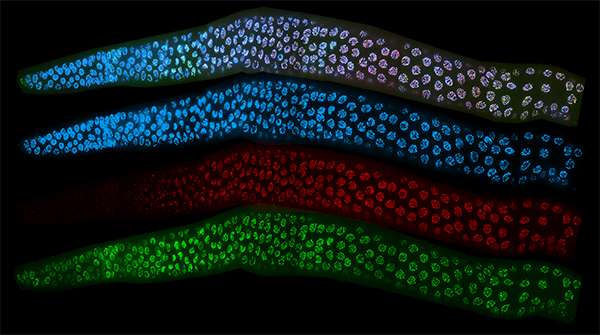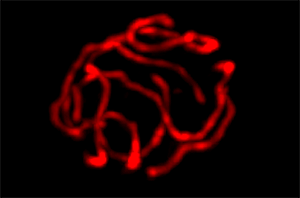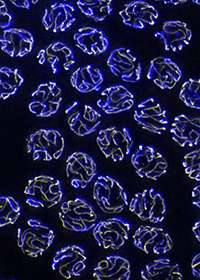Researchers find chemical tag that locks chromosomes together during meiosis

Chromosomes perform an intricate dance inside the nuclei of cells undergoing meiosis (dividing into sperm and eggs). One stumble can lead to infertility, miscarriage, birth defects or tumor formation.
Working with tiny Caenorhabditis elegans worms, a team of scientists led by Harvard Medical School has just figured out another critical part of the choreography, assigning a center-spotlight role to a common but poorly understood chemical modification.
In one step of the dance, each chromosome inherited from the mother pairs up with its counterpart inherited from the father. The dance partners then lock together from head to toe—held in place by a zipper-like structure called the synaptonemal complex—so they are poised to exchange DNA segments.
The researchers report in Genes and Development on Nov. 14 that they found a key that locks the chromosome partners together: a compound called acetyl that gets tacked on to the tip of a protein in the zipper.
"It's a chemical tag that is very commonly added onto the tips of proteins, but we know very few examples of what it does anywhere in the body," said Monica Colaiácovo, professor of genetics at HMS and senior author of the paper. "This is the first time it's been shown to have any biological function in meiosis."
Although worms are quite different from people, many basic aspects of meiosis, including construction of the synaptonemal complex, are shared across the two species. Genetic sequence analyses of mammalian proteins further raised the researchers' confidence that the findings are likely to translate to humans.
The implications of the findings, the researchers said, go beyond reproductive biology.
The team uncovered what they believe could be communication between protein-tip acetylation and other, more internal, chemical modifications, which might affect how that protein folds, interacts with other proteins and gets transported across membranes.

"As the icing on the cake," said Colaiácovo, "we found what most likely will prove to be a new code that could be regulating a lot of protein functions in ways we didn't predict."
"Biochemists may want to study the chemical modification itself and crosstalk with other modifications," said Jinmin Gao, a research fellow in genetics in the Colaiácovo lab and first author of the paper. "People interested in cancer may want to study whether mutations in the enzyme that delivers acetyl affect the function of other enzymes to drive tumorigenesis."
Zipped up
Colaiácovo's lab studies normal and abnormal chromosome distribution during meiosis and the effects errors can have on successive generations.
As part of that ongoing work, "we were looking for mutations that messed up meiosis," she said.
They found one.
A barrage of experiments zeroed in on one of the proteins in the synaptonemal complex, SYP-1. If the tip of the protein didn't get acetylated, the researchers discovered, the whole complex failed to stabilize.
That set off a cascade of additional failures where chromosome partners either didn't lock together or locked together improperly, made mistakes when they exchanged DNA segments, and led to sperm and eggs with too many or too few chromosomes.

"If you don't lock the structure in time or don't lock it properly, chromosome segregation will be affected and you or your embryo will have health issues, ranging from birth defects such as Down syndrome to more than a third of clinically diagnosed miscarriages," said Colaiácovo.
One molecule goes a long way
The researchers' work not only illuminated a critical aspect of meiosis but also revealed more about how proteins get acetylated in general. In doing so, they provided evidence that what they saw in C. elegans probably also happens in humans.
For instance, about 80 percent of proteins in humans are acetylated. Colaiácovo's group found that about 70 percent of proteins in worms are, too.
The researchers identified the enzyme that attaches the acetyl group to the SYP-1 protein and showed that the enzyme works the same way in worms as it does in humans.
They also pieced together a biochemical profile to help scientists recognize which protein ends are likely to attract an acetyl tag.
"If you have a signature, you can make predictions about whether your protein of interest is likely to be acetylated," said Colaiácovo.
Using their new profiling system, the researchers looked at proteins that form the synaptonemal complex in mammals and spotted those acetylation signatures—suggesting that human meiosis also relies on acetyl groups to hold chromosome dance partners together.
"I was surprised to find this high degree of conservation between something as simple as the worm and the complexity of humans," said Colaiácovo. "The fact that this is translating so nicely is further evidence that investing in research in model organisms can pay off in a big way."
More information: Jinmin Gao et al. N-terminal acetylation promotes synaptonemal complex assembly in, Genes & Development (2016). DOI: 10.1101/gad.277350.116


















